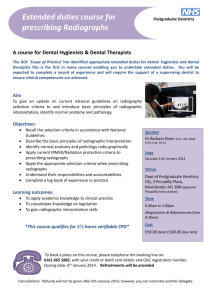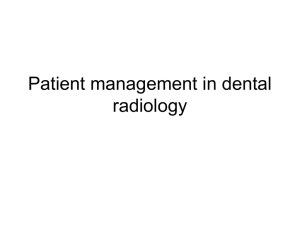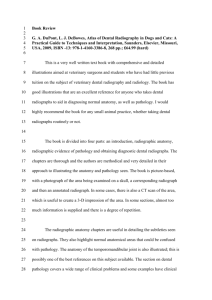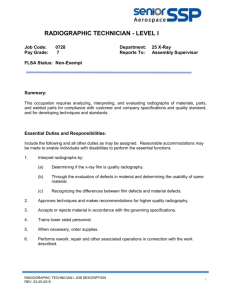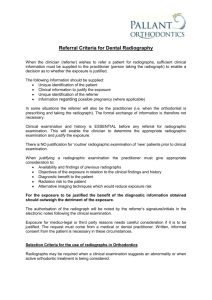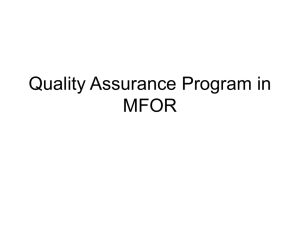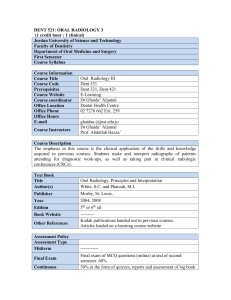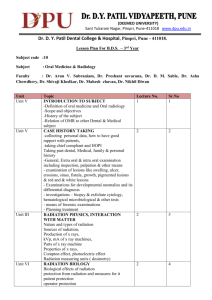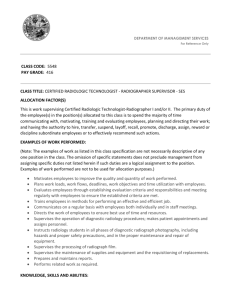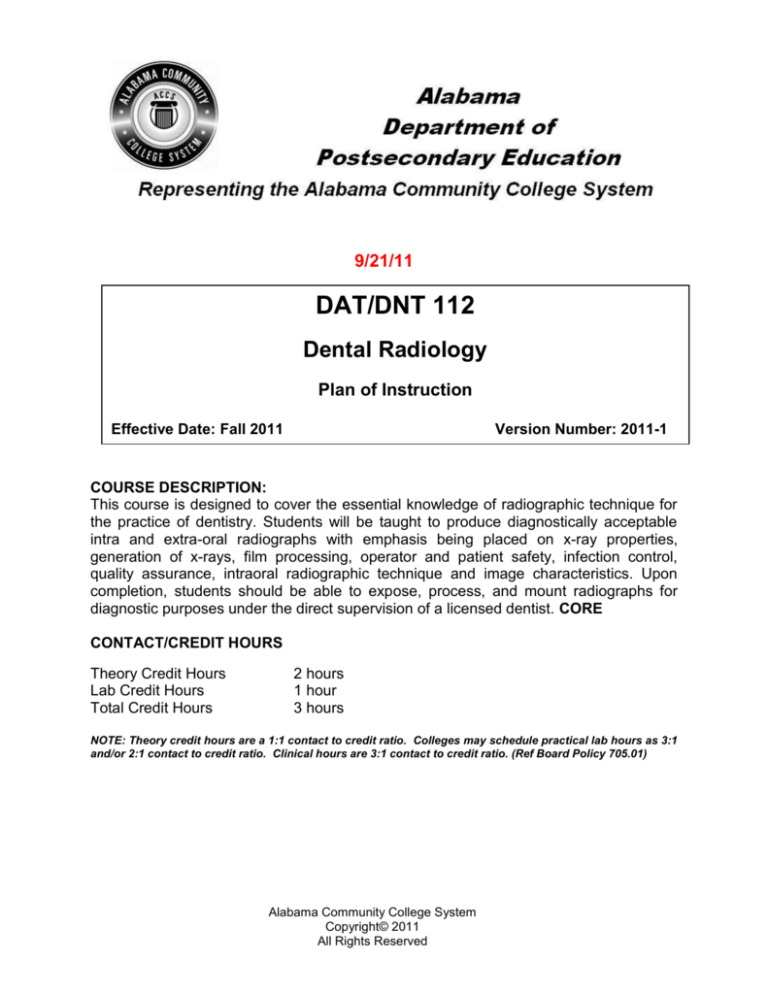
9/21/11
DAT/DNT 112
Dental Radiology
Plan of Instruction
Effective Date: Fall 2011
Version Number: 2011-1
COURSE DESCRIPTION:
This course is designed to cover the essential knowledge of radiographic technique for
the practice of dentistry. Students will be taught to produce diagnostically acceptable
intra and extra-oral radiographs with emphasis being placed on x-ray properties,
generation of x-rays, film processing, operator and patient safety, infection control,
quality assurance, intraoral radiographic technique and image characteristics. Upon
completion, students should be able to expose, process, and mount radiographs for
diagnostic purposes under the direct supervision of a licensed dentist. CORE
CONTACT/CREDIT HOURS
Theory Credit Hours
Lab Credit Hours
Total Credit Hours
2 hours
1 hour
3 hours
NOTE: Theory credit hours are a 1:1 contact to credit ratio. Colleges may schedule practical lab hours as 3:1
and/or 2:1 contact to credit ratio. Clinical hours are 3:1 contact to credit ratio. (Ref Board Policy 705.01)
Alabama Community College System
Copyright© 2011
All Rights Reserved
Dental Radiology
DAT/DNT 112
PREREQUISITE COURSES
As determined by college.
CO-REQUISITE COURSES
As determined by college.
PROFESSIONAL COMPETENCIES
Comprehend the foundational aspects of radiographs.
Identify and operate the various types of radiograph equipment.
Identify the various types and speeds of film, and describe the appropriate care
and storage of each.
Comprehend the principles of safe exposure of radiographs.
Perform various radiographic examinations.
Process and mount radiographs.
Discuss the desired features of radiographs and apply the appropriate corrective
action for errors.
INSTRUCTIONAL GOALS
Cognitive – Comprehend principles and concepts related to dental radiology.
Psychomotor – Apply principles of dental radiology.
Affective – Value the importance of adhering to policy and procedures related to
dental radiology.
STUDENT OBJECTIVES
Condition Statement: Unless otherwise indicated, evaluation of student’s attainment
of objectives is based on knowledge gained from this course. Specifications may be in
the form of, but not limited to, cognitive skills diagnostic instruments, manufacturer’s
specifications, technical orders, regulations, national and state codes, certification
agencies, locally developed lab/clinical assignments, or any combination of
specifications.
ACCS Copyright© 2011
All Rights Reserved
2
Dental Radiology
DAT/DNT 112
STUDENT LEARNING OUTCOMES
MODULE A – RADIOGRAPH FOUNDATIONS
MODULE DESCRIPTION – The purpose of this module is to teach the students the
foundational aspects of radiographs. Topics include the history of radiographs, and x-ray
emission properties and principles.
PROFESSIONAL COMPETENCIES
PERFORMANCE OBJECTIVES
KSA
A1.0 Comprehend the foundational
A1.1 This competency is measured
1
aspects of radiographs.
cognitively.
LEARNING OBJECTIVES
A1.1.1 Discuss historical events from the discovery of x-radiation to the present.
A1.1.2 Describe the theory and principles of radiation production.
MODULE A OUTLINE:
History of Radiographs
X-Ray emission
o Properties
o Principles
KSA
1
1
MODULE B – RADIOGRAPH EQUIPMENT
MODULE DESCRIPTION – The purpose of this module is to teach the students to identify
and operate the various types of radiograph equipment as well as to identify the various
types and speeds of film, and the appropriate care and storage of each. Topics include
equipment components, function, and settings, film speed, film types, film care and
storage, darkroom equipment, and duplication of radiographs.
PROFESSIONAL COMPETENCIES
PERFORMANCE OBJECTIVES
KSA
B1.0 Identify and operate the various B1.1 Safely operate radiographic
2
types of radiograph equipment.
equipment including the
adjustment of settings to meet
patient and film requirements.
B1.0 Identify the various types and
speeds of film, and describe
B1.1 Demonstrate appropriate
2
the appropriate care and
duplication procedures.
storage of each.
LEARNING OBJECTIVES
B1.1.1
B1.1.2
B1.1.3
B1.1.4
B1.1.5
B1.1.6
B1.1.7
Identify the various types of radiographic equipment.
Describe the function of the radiographic equipment.
Explain how to adjust equipment settings.
Differentiate between the various types and speeds of radiographic film.
Describe the proper care and storage of radiographic film.
Identify the components of the processing unit.
Explain care of darkroom equipment.
ACCS Copyright© 2011
All Rights Reserved
KSA
1
2
2
2
2
2
2
3
Dental Radiology
DAT/DNT 112
B1.1.8 Describe the function, safe use and disposal of the processing chemicals.
B1.1.9 Describe how to duplicate radiographs.
MODULE B OUTLINE:
Radiographic equipment
o Identify components
o Demonstrate function
o Adjust settings
X-Ray film
o Speed
o Types
o Care
o Storage
Darkroom equipment and apparatus
o Identify
o Operate
o Processing chemicals
Duplicating radiographs
3
2
MODULE C – RADIOGRAPHIC SAFETY
MODULE DESCRIPTION – The purpose of this module is to teach the students the
principles of safe exposure of radiographs. Topics include biological effects of radiation,
radiation protection, and OSHA standards and techniques for infection control.
PROFESSIONAL COMPETENCIES
PERFORMANCE OBJECTIVES
KSA
C1.0 Comprehend the principles of
C1.1 Demonstrate the safe exposure of
3
safe exposure of radiographs.
radiographs.
LEARNING OBJECTIVES
C1.1.1
C1.1.2
C1.1.3
C1.1.4
Discuss the biological effects of radiation on body tissue.
Summarize the radiation protection methods for the operator and patient.
Discuss the standards and techniques for radiologic infection control.
Explain the roles techniques and exposure choices play in preventing
unnecessary radiation exposure.
KSA
1
3
3
3
MODULE C OUTLINE:
Biological effects of radiation
Radiation protection (ALARA method)
o Patient
o Operator
OSHA standards and techniques for infection control
o Film
o Radiographic operatories
o Darkrooms
ACCS Copyright© 2011
All Rights Reserved
4
Dental Radiology
DAT/DNT 112
MODULE D – TYPES OF RADIOGRAPHIC EXAMINATIONS
MODULE DESCRIPTION – The purpose of this module is to teach the students to
perform various radiographic examinations. Topics include full mouth, panoramic,
periapical, occlusal, bitewing and digital radiographs.
PROFESSIONAL COMPETENCIES
PERFORMANCE OBJECTIVES
D1.0 Perform various radiographic
D1.1 Demonstrate various techniques
examinations.
when performing radiographic
examinations as specified.
LEARNING OBJECTIVES
D1.1.1 Describe the appropriate technique for a full mouth radiograph.
D1.1.2 Describe the appropriate technique for a panoramic radiograph.
D1.1.3 Describe the appropriate technique for a periapical radiograph.
D1.1.4 Describe the appropriate technique for a occlusal radiograph.
D1.1.5 Describe the appropriate technique for a bitewing radiograph.
D1.1.6 Describe the appropriate technique for a digital radiograph.
MODULE D OUTLINE:
KSA
2
KSA
2
2
2
2
2
2
Full Mouth radiographs (adult and pediatric)
o Position
o Expose
Panoramic radiograph
o Position
o Expose
Periapical radiograph
o Position
o Expose
Occlusal radiograph
o Position
o Expose
Bitewing radiograph
o Position
o Expose
Digital radiograph
o Position
o Expose
ACCS Copyright© 2011
All Rights Reserved
5
Dental Radiology
DAT/DNT 112
MODULE E – RADIOGRAPH PROCESSING AND MOUNTING
MODULE DESCRIPTION – The purpose of this module is to teach the students how to
process and mount radiographs. Topics include solution properties, processing
procedures, maintenance, types of mounts and mounting procedures.
PROFESSIONAL COMPETENCIES
PERFORMANCE OBJECTIVES
KSA
E1.0 Process and mount
E1.1 Demonstrate the proper technique
2
radiographs.
for processing radiographs.
E1.1
Demonstrate the proper technique
for mounting radiographs.
LEARNING OBJECTIVES
E1.1.1 Explain the functions of each processing chemical.
E1.1.2 List, in sequence the steps in processing dental film.
E1.1.3 Explain the role chemical replenishment and solution changes play in
maintaining the darkroom.
E1.1.4 Explain the cleaning procedure for processing equipment.
E1.1.5 Identify various types of x-ray mounts.
E1.1.6 Discuss the proper method for mounting radiographs.
2
KSA
1
3
2
2
1
2
MODULE E OUTLINE:
Processing
o Solution properties
o Procedures
o Maintenance
Solution
Equipment
Film
o Types of mounts
o Mounting procedures
ACCS Copyright© 2011
All Rights Reserved
6
Dental Radiology
DAT/DNT 112
MODULE F – RADIOGRAPHIC QUALITY & INTERPRETATION
MODULE DESCRIPTION – The purpose of this module is to teach the students the
desired features of radiographs and how to apply the appropriate corrective action for
errors. Topics include X-Ray density, contrast, definition, distortion, identification of
landmarks, exposure faults and processing faults.
PROFESSIONAL COMPETENCIES
PERFORMANCE OBJECTIVES
KSA
F1.0 Discuss the desired features of F1.1 Determine whether a radiograph
2
radiographs and apply the
is of an acceptable diagnostic
appropriate corrective action
quality and correct the errors as
for errors.
applicable.
LEARNING OBJECTIVES
F1.1.1 Describe the importance of proper density, contrast, definition, and
distortion.
F1.1.2 Describe how mA and kVp and exposure time affect film density and
image contrast.
F1.1.3 Describe how to prevent radiographic technique errors and image
distortion.
F1.1.4 Differentiate between normal and abnormal dental anatomy on
radiographs.
F1.1.5 Identify and correct non-diagnostic radiographs.
KSA
1
1
2
2
2
MODULE F OUTLINE:
X-Ray quality
o Density
o Contrast
o Definition
o Distortion
Interpretation
o Identification
Landmarks
Exposure faults
Processing faults
ACCS Copyright© 2011
All Rights Reserved
7
Dental Radiology
DAT/DNT 112
LEARNING OUTCOMES TABLE OF SPECIFICATIONS
The table below identifies the percentage of learning objectives for each module.
Instructors should develop sufficient numbers of test items at the appropriate
level of evaluation.
Limited
Knowledge and
Proficiency
KSA
Module A
Module B
Module C
Module D
Module E
Module F
1
100%
11%
25%
33%
40%
Moderate
Knowledge
and
Proficiency
2
Advanced
Knowledge
and
Proficiency
3
78%
11%
75%
100%
50%
60%
Superior
Knowledge
and
Proficiency
4
17%
The KSA is NOT determined by the verb used in the learning objective, but rather in the
context in which the verb is used and the depth of knowledge and skills required.
Example: Three KSA levels using the same verb (describe):
KSA 1 – Describe three characteristics of metamorphic rocks. (simple recall)
KSA 2 – Describe the difference between metamorphic and igneous rocks. (requires
cognitive processing to determine the differences in the two rock types)
KSA 3 – Describe a model that you might use to represent the relationships that exist
within the rock cycle. (requires deep understanding of rock cycle and a determination of
how best to represent it)
ACCS Copyright© 2011
All Rights Reserved
8
Dental Radiology
Indicator
1
Recall &
Reproduction
2
Skills &
Concepts
DAT/DNT 112
Learner’s Knowledge, Skills and Abilities
Key Terms
Description
Limited
Knowledge
and
Proficiency
Moderate
Knowledge
and
Proficiency
3
Strategic
Thinking
4
Extended
Thinking
Advanced
Knowledge
and
Proficiency
Superior
Knowledge
and
Proficiency
A
Attitudes and
Motivation
Affective
Objective
ACCS Copyright© 2011
All Rights Reserved
Identifies basic facts and terms about the subject or
competency.
Performs simple tasks associated with the competency.
Needs to be told or shown how to do most tasks.
Requires close supervision.
Identifies relationship of basic facts and states general
principles and can determine step-by-step procedures for
doing the competency.
Performs most parts of the competency. Needs help only
on hardest parts.
Requires limited supervision.
Analyzes facts and principles and draws conclusions about
the subject to include why and when the competency must
be done and why each step is needed. Can predict
outcomes.
Performs all parts of the competency. Needs only a spot
check of completed work.
Requires little or no direct supervision.
Can evaluate conditions and make appropriate decisions
as related to resolving problems.
Performs competency quickly and accurately with no direct
supervision and is able to instruct and supervise others.
Describes learning objectives that emphasize a feeling
tone, an emotion, or a degree of acceptance or rejection.
Objectives vary from simple attention to selected
phenomena to complex but internally consistent qualities
of character and conscience.
Expressed as interests, attitudes, appreciations, values,
and emotional sets or biases.
9

